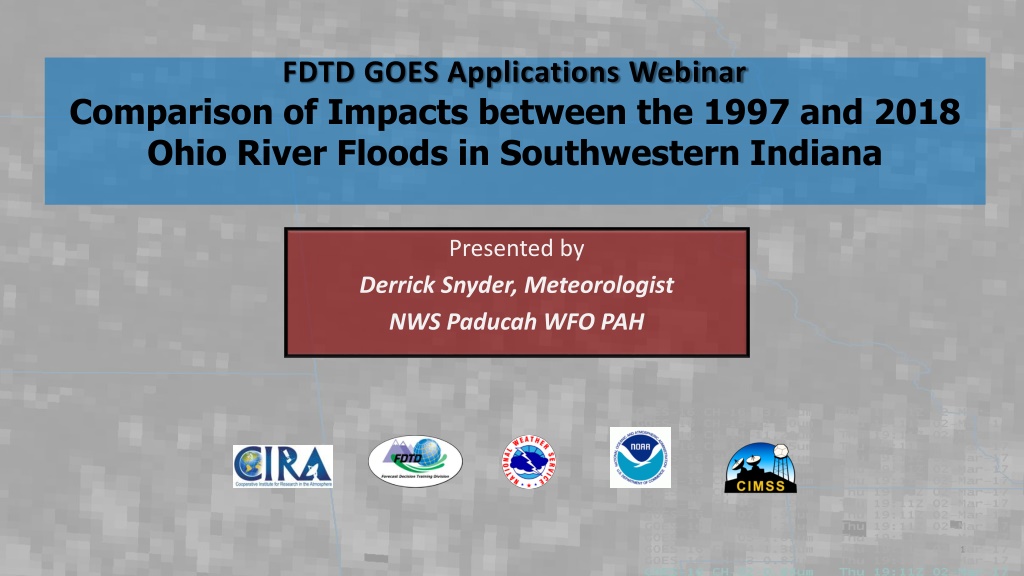Comparative Analysis of 1997 and 2018 Ohio River Floods in Indiana
Rounds of heavy rainfall in 2018 and 1997 resulted in significant flooding along the Ohio River in southwestern Indiana and northwestern Kentucky. While the crests were similar, the 2018 flood had more severe impacts in certain areas, leading to flash flooding, road inundation, and crop damage. The presentation by Meteorologist Derrick Snyder compares the effects of these two flood events, highlighting the differences in impact despite similar water levels.
Download Presentation

Please find below an Image/Link to download the presentation.
The content on the website is provided AS IS for your information and personal use only. It may not be sold, licensed, or shared on other websites without obtaining consent from the author. Download presentation by click this link. If you encounter any issues during the download, it is possible that the publisher has removed the file from their server.
E N D
Presentation Transcript
FDTD GOES Applications Webinar Comparison of Impacts between the 1997 and 2018 Ohio River Floods in Southwestern Indiana Presented by Derrick Snyder, Meteorologist NWS Paducah WFO PAH 1
FDTD Satellite Chat Library http://rammb.cira.colostate.edu/training/visit/satellite _chat/ Recorded Content includes Q&A Call for speakers! Let us know if you want to speak on a topic! Contact: scott.lindstrom@noaa.gov OR dan.bikos@noaa.gov 2
FDTD GOES Applications Webinar Protocol ~20 minutes for the speaker Send questions via GoTo Chat Or ask during Q&A period via phone Followed by Q&A Open discussion forum Done by 1830 UTC Do NOT press hold!!! Mute when not speaking 3
In February-March 2018, rounds of heavy rainfall fell over the Lower Ohio River Valley. This region received eight to ten inches of precipitation during February 2018, which was more than 200 percent of normal. Evansville, IN, recorded its wettest February on record, receiving 9.24 inches of precipitation. A comparable rainfall event occurred in early March 1997. Widespread rainfall amounts near 10 inches fell over three days from Louisville, KY, to Cincinnati, OH. 4
Both of these rainfall events resulted in high-impact river flooding from the Ohio River in southwest Indiana and northwest Kentucky. The Ohio River at Evansville, IN, crested at 46.87 feet on March 1, 2018, the highest crest since March 1997. On March 10, 1997, the Ohio River at Evansville crested at 47.52 feet, about 0.6 feet higher than the 2018 flood. March 1-10, 1997, estimated rainfall totals for across the Lower Ohio Valley. (Source: MRCC/cli-MATE) 6
While the 1997 and 2018 floods had similar crests, the impacts of the 2018 flood were more severe in some locations around southwestern Indiana. Backwater flooding of Pigeon Creek, an Ohio River tributary that flows through the Evansville metro area, made it vulnerable to flash flooding during heavy rain events. Sudden water rises on Pigeon Creek flooded road and neighborhoods with little warning. Floodwater from the Ohio River inundated roads and cropland at lower levels in the 2018 flood than in the 1997 flood. Below are examples where the impacts were more severe in the 2018 flood. (Photo credit: Evansville/Vanderburgh County (IN) EMA). 7
1 1 5 2 3 4 Back water from the Ohio River and runoff from heavy rain caused extensive flooding of Pigeon Creek. Several neighborhoods were threated by flood waters. The Split Window Difference 8
2 1 5 2 3 4 Waterworks Road flooded unexpectedly. This happened when the river was about a foot lower than the stage when it flooded in 1997. The Split Window Difference 9
3 1 5 2 3 4 Unprotected bottomlands and farm ground were inundated more extensively at a lower stage in the 2018 flood than in the 1997. Farm equipment and buildings that remained dry in the 1997 flood were damaged by flood waters in 2018. The Split Window Difference 10
4 1 5 2 3 4 Many homes were threatened by bottomland flooding south and east of Evansville, IN. The Split Window Difference 11
5 1 5 2 3 4 Back water flooding from the Ohio River and Pigeon Creek flooded several roads. Many roads flooded suddenly due to several rounds of quick-hitting heavy rainfall. The Split Window Difference 12
02 February 2018 1607 UTC The Split Window Difference 13
04 March 2018 1607 UTC The Split Window Difference 14
29 January 2019 1607 UTC The Split Window Difference 15
05 March 2019 1607 UTC The Split Window Difference 16
22 March 2019 1607 UTC The Split Window Difference 17
There is also a VIIRS-based river- flooding product that shows where floods are occurring (in yellow/orange/red) From Polar orbiters, sometimes you have only clouds (in grey) Imagery: William Straka CIMSS The Split Window Difference 18
River Flood Product is available in Real Earth (Imagery from Jorel Torres The Split Window Difference 19
GOES Version of Flood Product available via LDM in AWIPS (Daytime only) The Split Window Difference 20
Enhancing NWS Services During Significant River Flooding Events After the 2018 Ohio River flood, feedback from core partners (ex. emergency management, broadcast media, etc.), led in part to the National Weather Service (NWS) weather forecast office in Paducah, KY, implementing new tools to utilize during significant river flooding events. Beginning in 2019, NWS Paducah utilized playbooks to optimize staffing and delegate tasks depending on the severity of the river flooding. Another new tool is situation reports that provide a one stop shop overview of the current flooding threats. Additionally, NWS Paducah has greatly expanded using social media to share river forecasts and safety information. The Split Window Difference 21
The Split Window Difference 22 Examples of a river flooding staffing playbook (left), a situation report (right).
A social media graphic used by NWS Paducah beginning in 2019. The Split Window Difference 23























